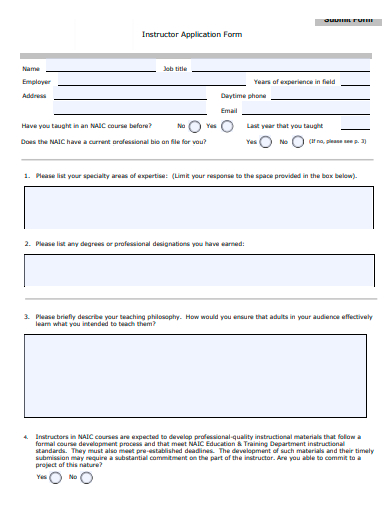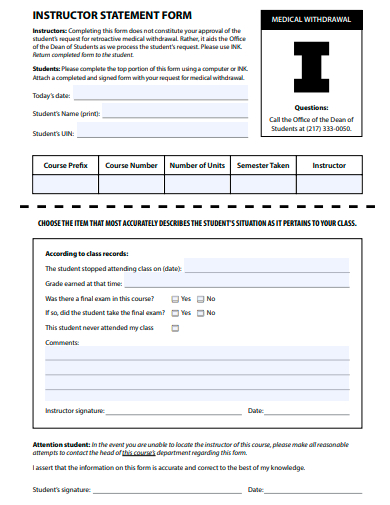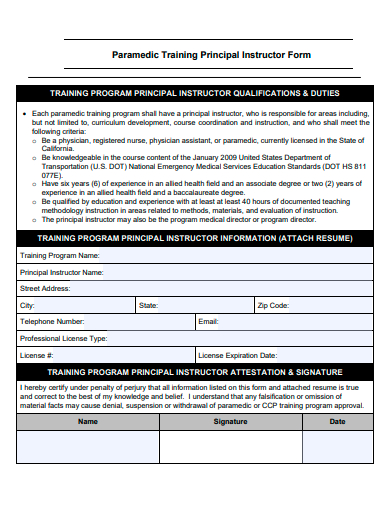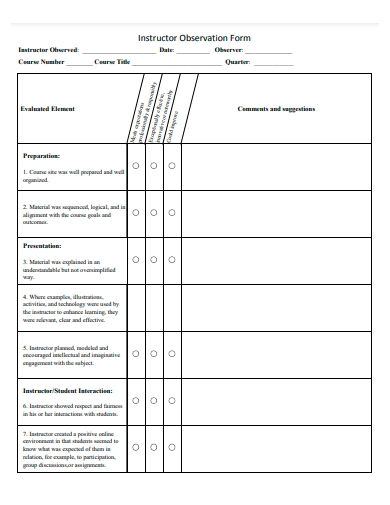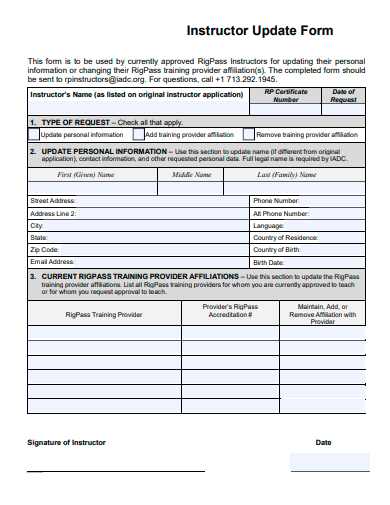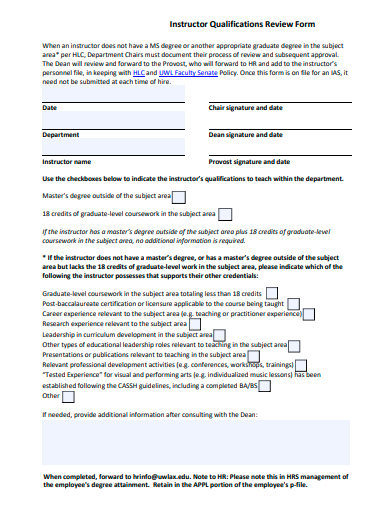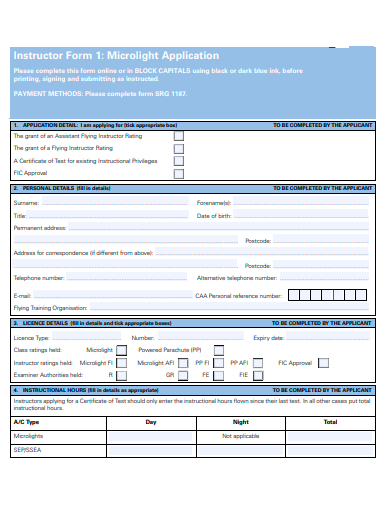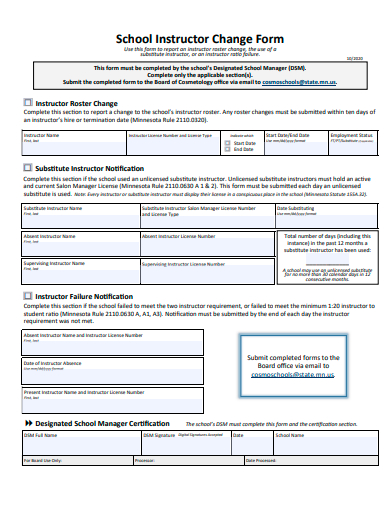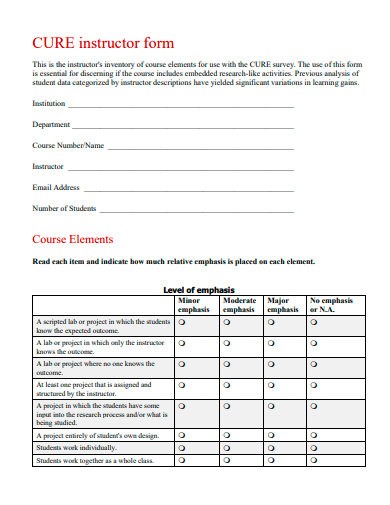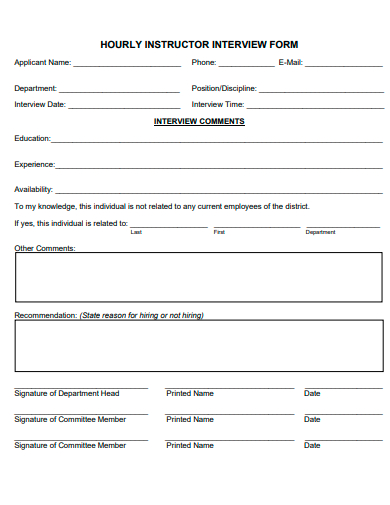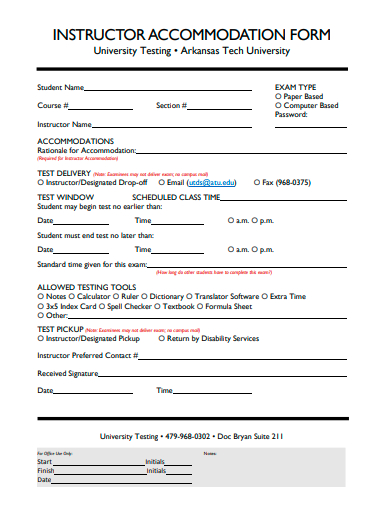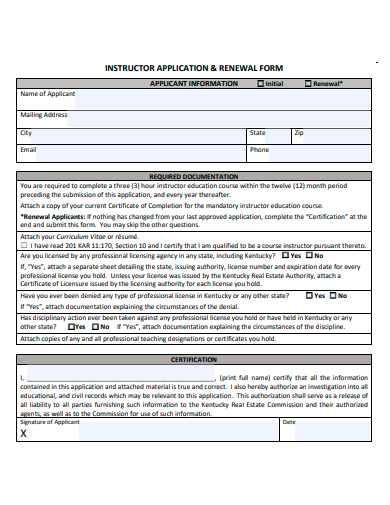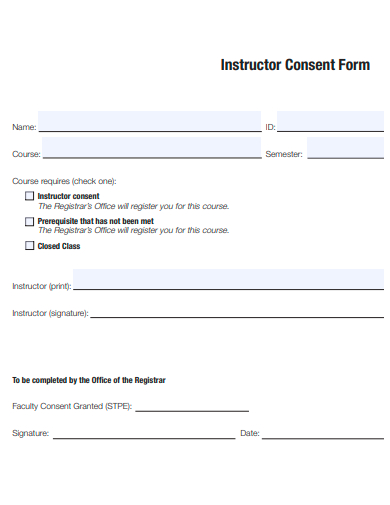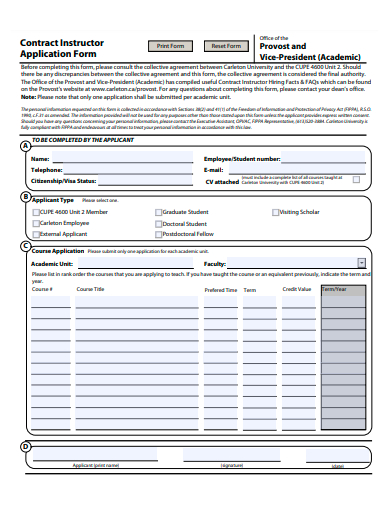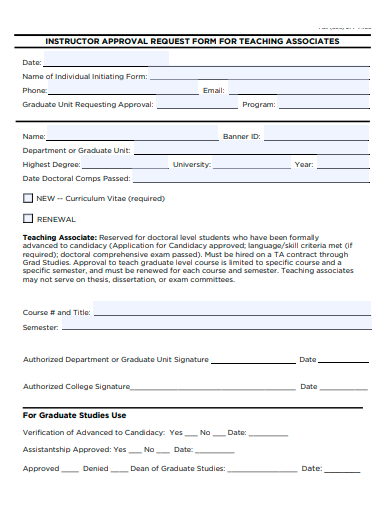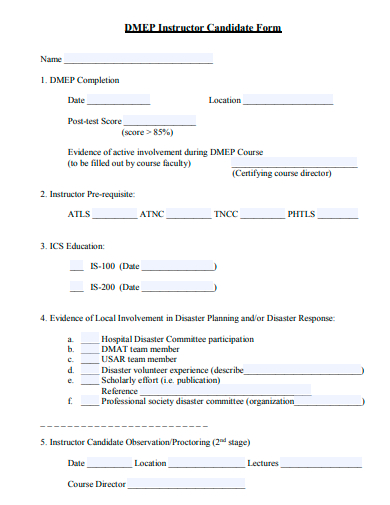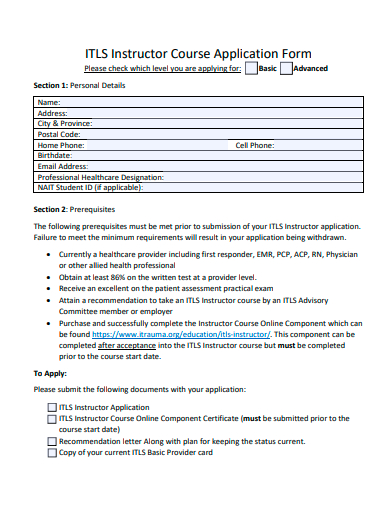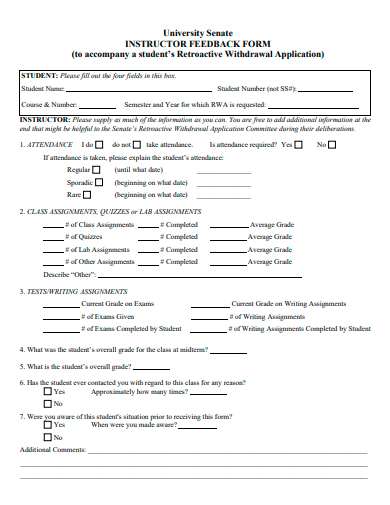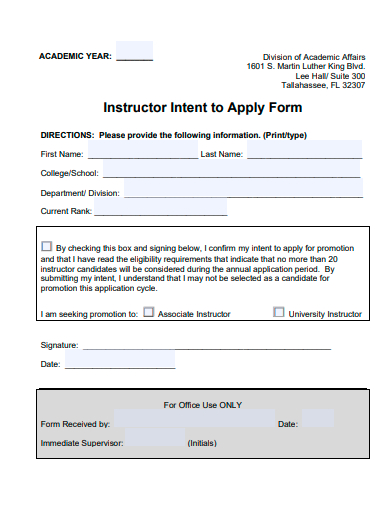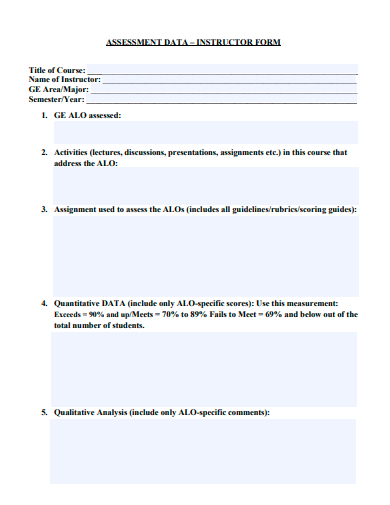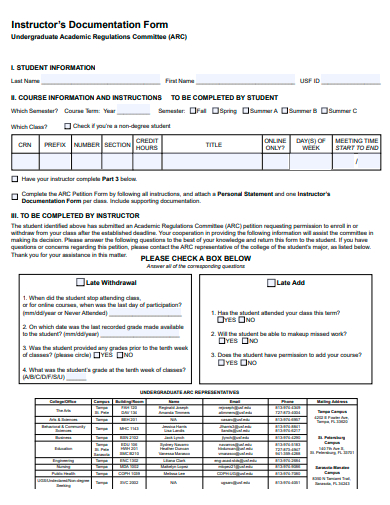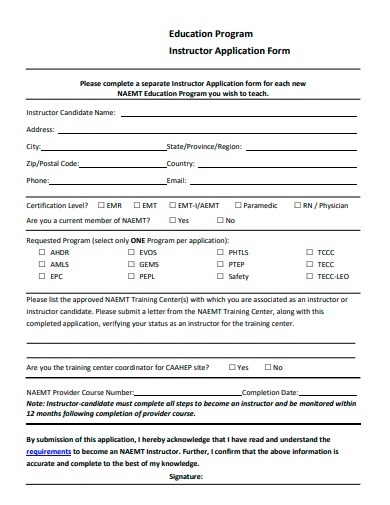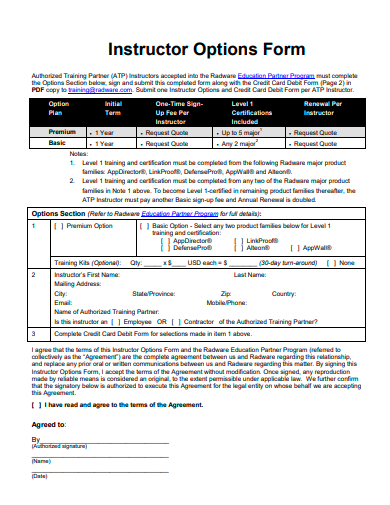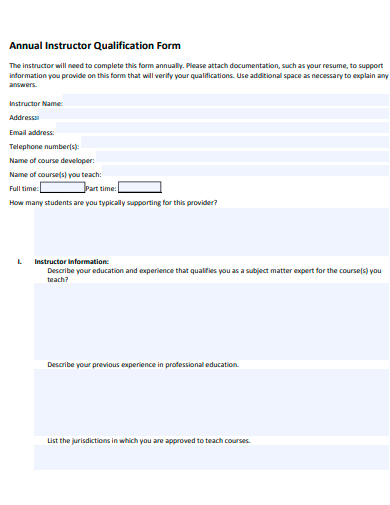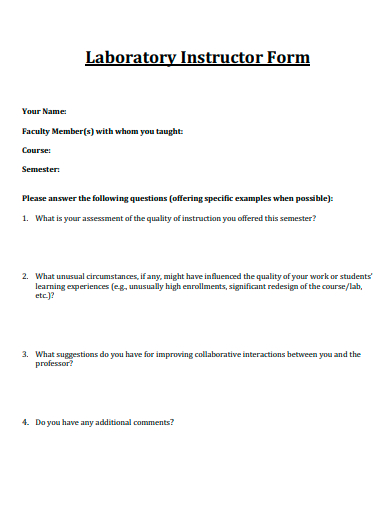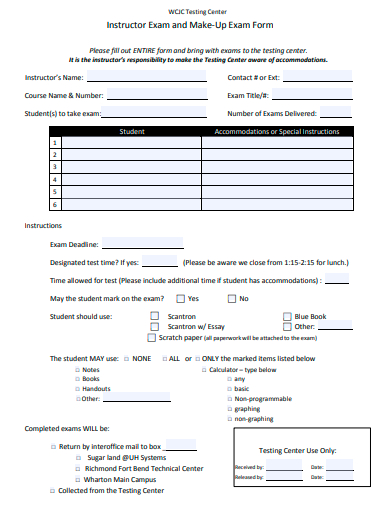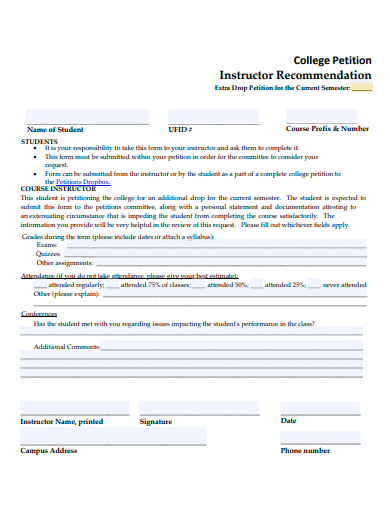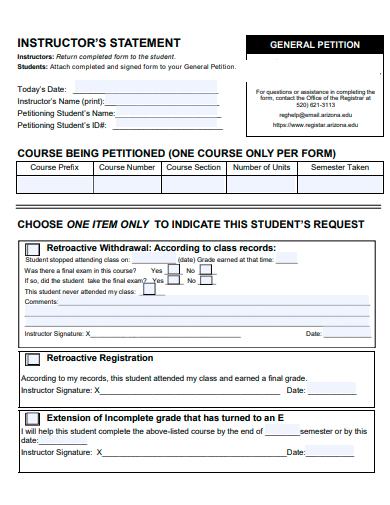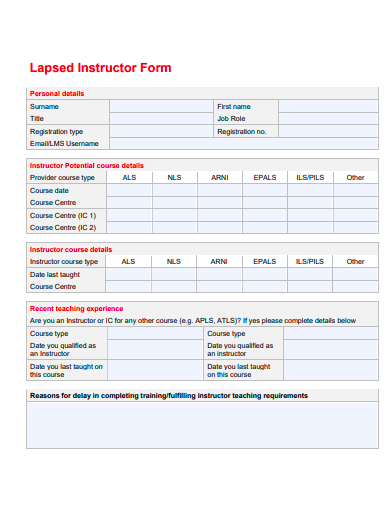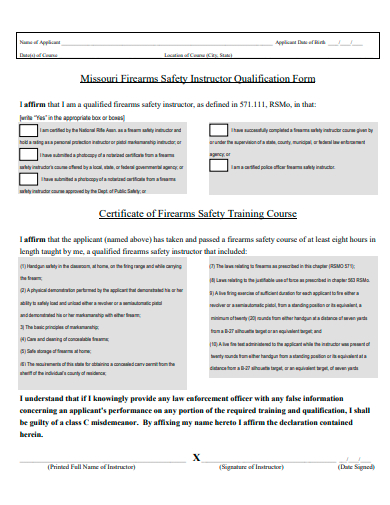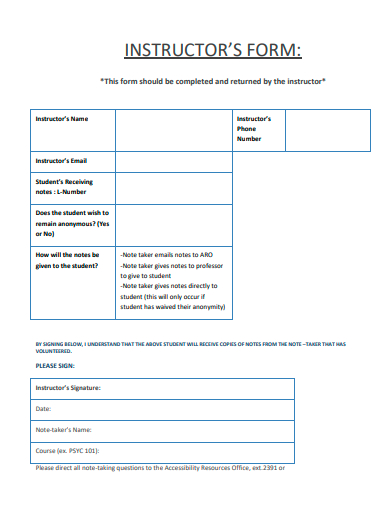Discover the ultimate resource for educators with our Sample Instructor Form Template, including an Evaluation Form. This versatile tool revolutionizes the way instructors manage their courses and assess student performance. Whether you’re a teacher, trainer, or professor, this template empowers you to create customized evaluation forms tailored to your needs. Streamline feedback collection, improve your teaching strategies, and elevate your educational impact. Take the first step towards more effective instruction by downloading our Sample Instructor Form Template with an integrated Evaluation Form today!
33+ Instructor Form Samples
1. Instructor Application Form Template
2. Instructor Statement Form Template
3. Early College Instructor Intent Form Template
4. Paramedic Training Principal Instructor Form Template
5. Instructor Observation Form Template
6. Instructor Update Form Template
7. Instructor Qualifications Review Form Template
8. Basic Instructor Form Template
9. School Instructor Change Form Template
10. Cure Instructor Form Template
What is an instructor form?
An instructor form, often referred to as a teacher or instructor evaluation form, is a structured document or questionnaire used in educational settings to assess and gather sample feedback on an instructor’s teaching performance, methods, and effectiveness. These forms are commonly employed in schools, colleges, universities, training programs, and various other learning environments. The primary purpose of an instructor form is to provide valuable insights into an instructor’s strengths and areas for improvement, ultimately enhancing the quality of education and teaching methods.
Here are some key aspects and elements typically found in an instructor form:
Course Information: An instructor form usually begins with basic course details, including the course name, code, and date. This information helps in identifying the specific course and instructor being evaluated.
Student Information: It often includes a section for students to provide their names, student IDs, or other identifiers to ensure accurate feedback tracking. In some cases, sample forms may be anonymous to encourage honest feedback.
Rating Scales: One of the central components of an instructor form is a set of rating scales. These scales typically range from poor to excellent or use numerical values (e.g., 1 to 5) to assess various aspects of the instructor’s performance. Common categories for assessment include course content, teaching effectiveness, communication, and organization.
Open-Ended Questions: Alongside rating scales, open-ended questions are frequently included to allow students to provide specific comments, suggestions, and qualitative feedback. These questions often ask about what the instructor does well and where they could improve.
Teaching Methods: Instructor forms often inquire about the teaching methods employed by the instructor. Students may be asked to evaluate the effectiveness of lectures, discussions, general assignments, or any other instructional techniques used.
Course Materials: Students are usually given the opportunity to comment on the course materials, such as textbooks, handouts, and online resources, assessing their relevance and usefulness.
Communication Skills: Effective communication is a critical aspect of teaching. Instructor forms often include questions related to an instructor’s ability to explain concepts clearly, engage students in discussions, and respond to questions.
Overall Satisfaction: Many forms conclude with a question asking students to rate their overall satisfaction with the course and the instructor. This provides a summary assessment of the instructor’s performance.
Suggestions for Improvement: In addition to providing feedback, students are often encouraged to offer constructive suggestions for how the instructor can enhance their teaching methods or course content.
Confidentiality: It’s important to reassure students that their responses will be kept confidential, especially if anonymity is not guaranteed. This encourages students to provide honest feedback without fear of reprisal.
Instructor forms play a crucial role in the ongoing professional development of educators. The feedback collected through these forms helps instructors identify their strengths and weaknesses, make necessary adjustments to their teaching methods, and continuously improve the quality of education they provide. Moreover, educational institutions use the data from instructor forms for performance evaluations, tenure decisions, and curriculum enhancements. In this way, instructor forms are an integral part of ensuring that the educational experience is enriching, engaging, and effective for students and instructors alike.
11. Hourly Instructor Interview Form Template
12. Instructor Accommodation Form Template
13. Instructor Application and Renewal Form Template
14. Instructor Consent Form Template
15. Contract Instructor Application Form Template
16. Instructor Approval Request Form Template
17. Instructor Candidate Form Template
18. Instructor Course Application Form Template
19. Instructor Feedback Form Template
20. Instructor Intent to Apply Form Template
21. Instructor Form Example
22. Instructors Documentation Form Template
What’s the difference between an instructor and a teacher?
The terms “instructor” and “teacher” are often used interchangeably, but they can have nuanced differences in certain contexts. These differences may vary depending on the educational setting, the roles and responsibilities assigned, and the specific terminology used by institutions. Below, we explore the distinctions between an instructor and a teacher:
Educational Setting:
Teacher: The term “teacher” is more commonly associated with primary and secondary education. Teachers in these settings are responsible for imparting knowledge and skills to students in subjects like math, science, language arts, and social studies. They often follow a structured curriculum and are responsible for classroom management.
Instructor: Instructor is a broader term used in various educational contexts, including higher education, vocational training, and specialized courses. Instructors can be found in colleges, universities, trade schools, and professional development programs. They teach a wide range of subjects, including academic disciplines, technical skills, and professional courses.
Formal Qualifications:
Teacher: In many countries, teachers in primary and secondary education are required to have formal training and certification in education, which includes coursework in pedagogy and classroom management.
Instructor: Instructors in higher education and vocational training may have expertise in their field but may not always have formal education degrees. They are often hired for their practical experience and specialized knowledge.
Curriculum and Autonomy:
Teacher: Teachers in primary and secondary education typically follow a standardized curriculum set by educational authorities. They have less autonomy in designing course content.
Instructor: Instructors in higher education often have more freedom to design their courses and curriculum, particularly at the college or university level. They may have input into the content and structure of their courses.
Age of Students:
Teacher: Teachers typically work with students who are children and teenagers, ranging from kindergarten to 12th grade.
Instructor: Instructors often work with adults or post-secondary students, including college-aged individuals and adult learners.
Classroom Management:
Teacher: Classroom management is a significant aspect of a teacher’s role, as they are responsible for maintaining discipline and order among younger students.
Instructor: Instructors may have fewer classroom management challenges, as their students are often adults or individuals pursuing specific training.
Teaching Approach:
Teacher: Teachers often focus on foundational knowledge and skills, as their students are at earlier stages of learning.
Instructor: Instructors, especially in higher education, may delve into more specialized and advanced topics, assuming a higher level of prior knowledge.
It’s important to sample note that these distinctions are not universally applicable, and the terms teacher and instructor may be used differently in various regions and educational institutions. Additionally, the roles of educators are evolving, with many instructors in higher education taking on responsibilities traditionally associated with teachers, such as curriculum development and student mentorship. Therefore, the boundaries between these roles can be fluid, and the specific duties of an individual in either role can vary widely.
23. Education Program Instructor Application Form Template
24. Instructor Options Form Template
25. Continuing Education Instructor Approval Form Template
26. Annual Instructor Qualification Form Template
27. Laboratory Instructor Form Template
28. Instructor Exam and Make-Up Form Template
29. College Petition Instructor Recommendation Form Template
30. Instructors Statement Form Template
31. Lapsed Instructor Form Template
32. Firearms Safety Instructor Qualification Form Template
33. Instructor Form Template
34. Instructor Assessment Form Template
How to create an Instructor Form?
Creating an instructor form, also known as a teacher or instructor evaluation form, involves several steps to design a structured and effective tool for gathering feedback on an instructor’s performance. Whether you are a school administrator, a faculty member, or an instructional designer, here’s a step-by-step guide on how to create an instructor form:
Determine the Purpose and Goals:
Clarify the objectives of the evaluation. Are you looking to assess teaching effectiveness, course content, or other aspects of instruction? Understanding the purpose will guide the form’s design.
Define Evaluation Criteria:
Identify the specific areas or criteria you want to evaluate. Common criteria include teaching methods, communication skills, content relevance, and overall satisfaction.
Decide on the Format:
Choose the format of your instructor form. Will it be paper-based or digital? Online forms are often more convenient for respondents and provide easier data collection and sample analysis.
Create a Clear Title and Introduction:
Craft a concise and informative title for your form. In the introduction, explain the purpose of the evaluation, reassure respondents about anonymity if applicable, and set expectations for providing honest feedback.
Develop Questions:
Based on your defined criteria, create a set of questions. These can be in the form of rating scales (e.g., on a scale of 1 to 5) or open-ended questions. Ensure questions are clear, specific, and unbiased.
Use a Mix of Question Types:
To gather comprehensive feedback, include a mix of question types. For example, use Likert scale questions for quantitative data and open-ended questions for qualitative insights.
Pilot Test the Form:
Before deploying the form widely, pilot test it with a small group to identify any issues with question clarity, wording, or formatting. Make necessary adjustments based on feedback.
Organize Questions Logically:
Arrange questions in a logical order, starting with general questions and progressing to more specific ones. Group related questions together to maintain coherence.
Include Space for Comments:
Provide space for respondents to leave comments or suggestions. This allows for more detailed and context-rich feedback.
Ensure Anonymity (if Desired):
– If anonymity is important, make sure the form does not collect personal information that could identify respondents. This encourages candid responses.
Add a Closing Statement:
– Conclude the form with a thank-you message for participating and emphasize the value of the feedback in improving instruction.
Design and Branding:
– Pay attention to the form’s visual design review. Use consistent fonts and colors, and consider adding your institution’s logo or branding elements.
Test the Form:
– If using an online platform or survey tool, thoroughly test the form to ensure it works correctly and that data is collected and stored securely.
Distribute and Collect Responses:
– Deploy the form to the target audience, whether it’s students, colleagues, or participants. Monitor responses and set a deadline for submission.
Analyze and Act on Feedback:
– Once responses are collected, analyze the data to identify strengths and areas for improvement. Share the results with the instructor and take action based on the feedback received.
Iterate and Improve:
– Use the feedback from the instructor form to make continuous improvements in the evaluation process and the form itself for future assessments.
Creating an effective instructor form involves careful sample planning, thoughtful question design, and a commitment to using the feedback to enhance the quality of instruction. Regularly reviewing and refining the form based on the evolving needs of your institution or program ensures that it remains a valuable tool for assessing teaching effectiveness.
Related Posts
Sample Sworn Affidavit Forms
Vehicle Inspection Forms Samples & Templates
Sample Employee Advance Forms
Sample Child Travel Consent Forms
Sample Testimonial Request Forms
Sample Employee Details Forms
Sample Divorce Forms
Sample Attestation Forms
Employee Performance Appraisal Form Templates
FREE 9+ Sample Presentation Evaluation Forms in MS Word
FREE 10+ School Admission Form Samples & Templates in MS Word | PDF
FREE 30+ Patient Consent Form Samples in PDF | MS Word
FREE 10+ Sample Sign Off Form Templates in PDF | MS Word
FREE 11+ Sample Medical Consultation Forms in PDF | MS Word
FREE 8+ Sample Donation Forms in PDF | MS Word

